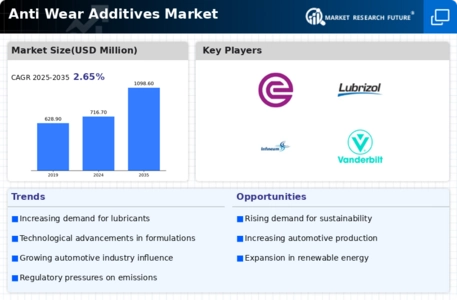Market Share
Anti Wear Additives Market Share Analysis
The production of crude oil plays a significant role in driving the market for hydraulic fluids. Hydraulic fluids are substances used in hydraulic systems, and they are made from crude oil through various processes. The increasing production of crude oil in recent years is a major factor influencing the global market for hydraulic fluids. One of the main industries driving this demand is the oil and gas sector, which relies heavily on hydraulic fluids for various purposes.
In the oil and gas industry, hydraulic systems are widely used for activities such as fracking, drilling, and creating high pressure during crude oil production. These hydraulic systems require hydraulic fluids for power transmission, lubrication, and protection against corrosion. As the production of crude oil continues to rise, the use of hydraulic systems in the oil and gas sector also increases, leading to a substantial demand for hydraulic fluids.
The oil and gas industry is a key player in consuming hydraulic fluids, and its robust demand is a result of the extensive utilization of hydraulic systems. Hydraulic fluids, derived from crude oil, play a crucial role in ensuring the smooth operation of hydraulic systems in this industry. The hydraulic systems are vital for various functions within the oil and gas sector, and their widespread use contributes to the escalating demand for hydraulic fluids.
The significance of hydraulic fluids lies in their ability to facilitate power transmission, provide lubrication, and prevent corrosion in hydraulic systems. With the rise in crude oil production, hydraulic systems have become integral in the oil and gas industry, thereby driving the substantial demand for hydraulic fluids. The versatile applications of hydraulic systems, ranging from fracking to drilling, highlight the diverse needs within the oil and gas sector, all of which contribute to the increased consumption of hydraulic fluids.
In summary, the surge in crude oil production has emerged as a major driving force behind the growing demand for hydraulic fluids. The oil and gas industry, being a key consumer of hydraulic fluids, heavily relies on hydraulic systems for its operations. As these hydraulic systems become more prevalent in activities such as fracking and drilling, the need for hydraulic fluids continues to rise. The multifunctional role of hydraulic fluids in ensuring the efficiency and durability of hydraulic systems further emphasizes their importance in meeting the demands of the expanding oil and gas sector.







Leave a Comment